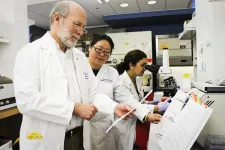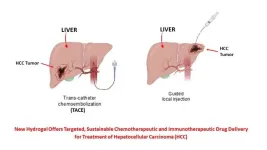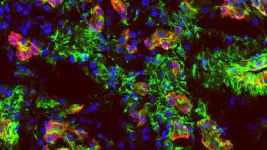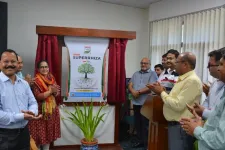(Press-News.org) ST. LOUIS – Each year, tuberculosis (TB) kills more people than any other infectious disease, falling out of the top spot only temporarily during the COVID-19 pandemic.
Despite TB’s wide reach and some lost progress during the COVID-19 pandemic, researchers believe it is possible to eradicate TB through advances in vaccine development and public health. To cross the finish line, scientists must find ways to test new vaccines rapidly to prevent TB infections more effectively.
In a paper published in the Journal of Infectious Diseases, Daniel Hoft, M.D., Ph.D., director of the Saint Louis University Center for Vaccine Development, and colleagues from Saint Louis University, Emory University School of Medicine, The Emmes Company, LLC, the National Institute of Allergy and Infectious Diseases, part of the National Institutes of Health, and New York University Grossman School of Medicine, report a promising new approach to speed vaccine testing for TB.
Hoft, who also serves as professor and chair of infectious diseases, allergy, and immunology at the Saint Louis University School of Medicine, sought data that could only be gathered by challenging the human immune system directly. This approach, Hoft hypothesized, could provide answers to some TB unknowns. For example, TB animal models do not fully mimic how the bacteria behaves in people, and vaccine developers do not have well-defined data about what TB immune responses offer optimal protection against the bacteria.
To test new vaccines, infectious diseases researchers sometimes conduct human challenge studies to quickly learn about how well a vaccine candidate works against an infectious disease, such as influenza. In these studies, researchers first deliver an investigational vaccine or placebo to separate groups of healthy volunteers, and then intentionally infect study participants with a flu virus, all in carefully controlled settings and under close medical supervision, to determine whether the investigational experimental vaccine provides protection compared with the control group. This approach can be instrumental in generating data supporting the approval of novel vaccines.
Mycobacterium tuberculosis, the bacteria that cause TB, however, is too dangerous for human challenge with the fully pathogenic bacteria. The team needed to find another, safer way to challenge the human immune system to find answers to their questions.
Hoft found a workaround in the Bacillus Calmette-Guérin (BCG) vaccine.
The most widely used vaccine in history, with more than 4 billion doses given to patients since 1921, the BCG vaccine contains a live but weakened version of the TB bacteria. The BCG vaccine is given to newborns to reduce their TB risk, but it is less effective against pulmonary TB and often wanes in effectiveness, providing little to no protection in adults.
With the BCG vaccine, Hoft saw a chance to gather data about TB in a human study without the risk of exposing participants to full strength M. tuberculosis bacteria. To test this idea, the researchers gave 92 healthy adults the BCG vaccine, with participants receiving one of four different doses.
With participants’ immune response to the BCG vaccine serving as a proxy for their exposure to a true infection, the researchers gathered much-needed data about how the immune system responds when it encounters TB.
The team applied a battery of analysis methods to samples collected from the BCG challenge sites and blood, looking for associations between BCG at the injection site, and immune responses as well as gene expression changes in blood.
The findings open up new doors for TB vaccine development.
“Our findings are important for two reasons,” Hoft said. “First, this approach could enable us to screen new TB vaccines early in the pipeline and prioritize the most promising concepts, saving time and money.”
“Second, we have a model to better determine what a new vaccine needs to do to protect against TB. We will be able to identify biomarkers indicating whether new vaccines could better protect someone against TB.”
Among the findings that will help vaccine developers as they create new vaccines,
The researchers determined that BCG challenge doses of up to 8 x 106 CFU were safe.
They found that BCG at the challenge sites increases as the BCG dose increases.
The researchers identified the most consistent and precise measure of BCG at challenge sites.
Gene expression analysis found potential biomarkers of immunity that correlated with inhibition of BCG in people that may provide a TB protective signature.
And they uncovered immunological and gene expression differences that could underlie the different risks of men and women developing active TB.
This last point is an intriguing finding. Doctors have long observed that men appear to be more at risk of developing an active form of TB infection, but they do not know why. In this study, researchers found differences in the immune responses of men and women to the BCG challenge, a finding that parallels doctors’ observations with patients who develop the illness.
Researchers hope this new model will help advance our understanding of why men and women have different levels of general immunity.
Hoft is enthused by the study’s findings, which he says could provide a road map for future TB vaccine testing.
“The BCG human challenge model is a promising approach for studying TB immunity,” Hoft said. “The new data will facilitate the vaccine development process, allowing us to make progress toward our ultimate goal of eradicating TB.”
Research reported in this study was supported by the National Institute of Allergy and Infectious Diseases, part of the National Institutes of Health under award numbers HHSN272200800003C (SLU), HHSN272201300021I (SLU), HHSN272200800005C (Emory), and HHSN272201300018I (Emory).
The content in this press release is solely the responsibility of the authors and does not necessarily represent the official views of the National Institutes of Health.
About the Saint Louis University Center for Vaccine Development
Saint Louis University has been on the front lines in the fight against pandemics and global health crises for more than three decades and first received federal funding for vaccine research in 1989. Led by Daniel Hoft, M.D., Ph.D., SLU’s Center for Vaccine Development is one of only 10 institutions selected by the National Institutes of Health as a Vaccine and Treatment Evaluation Unit (VTEU). As a VTEU, the Center helps develop and evaluate vaccines that will protect people from infectious diseases and emerging threats. It conducts Phase 1 through 4 vaccine and treatment trials, including clinical studies in collaboration with industry partners.
About the Saint Louis University School of Medicine
Established in 1836, Saint Louis University School of Medicine has the distinction of awarding the first medical degree west of the Mississippi River. The school educates physicians and biomedical scientists, conducts medical research, and provides health care on a local, national and international level. Research at the school seeks new cures and treatments in five key areas: infectious disease, liver disease, cancer, heart/lung disease, and aging and brain disorders.
END
To build better tuberculosis vaccines, Saint Louis University researchers develop a new model by leveraging an old vaccine
Scientists believe they can use one vaccine to study others
2023-11-29
ELSE PRESS RELEASES FROM THIS DATE:
Improving our understanding of the effects of PFOS on fish
2023-11-29
Two papers recently published in Environmental Toxicology and Chemistry have made important advancements toward understanding the effects of perfluorooctane sulfonate (PFOS) on aquatic life, especially fish. Zebrafish had been identified in a previous study of limited scope as being among one of the most sensitive aquatic species to PFOS, and the results of that limited-scope study have influenced PFOS water quality criteria derived by some regulatory agencies, including the Australian Environmental Protection Agency (EPA).
Kurt Gust and ...
Enhanced treatment of liver carcinoma with a drug-eluting hydrogel
2023-11-29
(LOS ANGELES) – November 29, 2023 - Scientists from the Terasaki Institute for Biomedical Innovation (TIBI) have developed an injectable or catheter-administered hydrogel with enhanced capabilities for treating hepatocellular carcinoma (HCC), a deadly form of liver cancer. As described in their recent publication in Advanced Functional Materials, this drug-eluting hydrogel can provide sustained, pH-dependent drug co-delivery and has capabilities for promoting anti-tumor immune responses. This reduces tumor cell proliferation and growth and offers a more efficient means of enabling tumor cell death.
Worldwide, HCC is a leading cause of ...
Applying semiconductor manufacturing principles to optoelectronic devices
2023-11-29
Optoelectronics detect or emit light and are used in a variety of devices in many different industries. These devices have historically relied on thin transistors, which are small semiconductors that control the movement of electrons and photons, made out of graphene and other two-dimensional materials. However, graphene and these other materials often have problems with band gap opening and other shortcomings that have researchers searching for an alternative.
When treated with a method called the ...
The role of marketing in disrupted health care markets: It’s time to move beyond conventional strategies to account for new actors, roles, and exchanges
2023-11-29
Researchers from Duke University, University of New South Wales, University of Wisconsin, and University of Washington published an editorial for the Journal of Marketing that calls for marketing to tackle the challenges and opportunities in dynamic contemporary health care markets.
The editorial, introducing a special issue on “Marketing in the Health Care Sector” for the Journal of Marketing, is titled “Marketing in the Health Care Sector: Disrupted Exchanges and New Research Directions” and is authored by Christine Moorman, Harald J. van Heerde, C. Page Moreau, and Robert W. Palmatier. The special issue ...
Can we crack this cancer’s immune response?
2023-11-29
Recent findings at Cold Spring Harbor Laboratory (CSHL) shine a new light on pancreatic cancer.
More than 90% of pancreatic cancer cases are attributed to an aggressive, deadly form of the disease called pancreatic ductal adenocarcinoma, or PDAC. Researchers have a poor understanding of how our immune system interacts with PDAC. So, coming up with treatments is tricky. It’s thought patients do not show a natural immune response to the cancer because the tumor environment somehow prevents that response. Many are unconvinced that PDAC ...
Building blocks for life could have formed near new stars and planets
2023-11-29
While life on Earth is relatively new, geologically speaking, the ingredients that combined to form it might be much older than once thought. According to research published in ACS Central Science, the simplest amino acid, carbamic acid, could have formed alongside stars or planets within interstellar ices. The findings could be used to train deep space instruments like the James Webb Space Telescope to search for prebiotic molecules in distant, star-forming regions of the universe.
It has long been hypothesized that one of the building blocks for life, amino acids, could have formed during reactions in the “primordial ...
Uttam Superrhiza named as winner of Applied Microbiology International Product of the Year 2023
2023-11-29
Mycorrhiza biofertilizer Uttam Superrhiza has been named as the winner of the Applied Microbiology International Product of the Year 2023.
The prestigious prize recognizes a commercial product derived from microbiology research, with special consideration given to those products that have addressed the United Nations Sustainable Development Goals.
Uttam Superrhiza, marketed by Chambal Fertilizers and Chemicals Limited in India, is manufactured by the not-for-profit institute, The Energy and Resources Institute (TERI).
Disruptive mycorrhiza
A disruptive ...
Contactless Coupler, the innovation and advancement in the connection of precast concrete member
2023-11-29
The Korea Institute of Civil Engineering and Building Technology (KICT, President Kim, Byung-Suk) has developed a new Contactless Coupler that can efficiently improve the constructability of precast concrete (hereinafter referred to as PC).
Recently, Off-site Construction (OSC) has been actively used worldwide to solve the problems at complex construction sites. The OSC method minimizes on-site work by prefabricating parts of the structure and then simply assembling and constructing them on-site. In particular, Korean construction sites are promoting OSC to solve the problem of aging skilled workers and labor shortages.
The PC method, one of the representative OSC methods, is a method ...
Swapping blood for spit — for convenient at-home health monitoring
2023-11-29
Blood tests are a common, yet often painful, step in health care. But what if we could skip the needles altogether? Saliva and blood contain many of the same biomarkers, and collecting spit is as simple as drooling into a container. Researchers reporting in ACS Sensors have developed a device that detects glucose and adenosine monophosphate (AMP) biomarkers in saliva with high sensitivity, which could help make at-home health monitoring easier and without a poke.
Blood tests provide critical information about a person’s health. But they also rely on uncomfortable procedures, ranging from collecting small blood samples through frequent finger pricks to blood draws from ...
Conscientious personalities less at risk of dementia diagnosis
2023-11-29
People with personality traits such as conscientiousness, extraversion and positive affect are less likely to be diagnosed with dementia than those with neuroticism and negative affect, according to a new analysis by researchers at the University of California, Davis and Northwestern University. The difference was not linked to physical damage to brain tissue found in dementia patients, but more likely to how certain personality traits help people navigate dementia-related impairments.
The work is published Nov. ...
LAST 30 PRESS RELEASES:
The perfect plastic? Plant-based, fully saltwater degradable, zero microplastics
Bias in data may be blocking AI’s potential to combat antibiotic resistance
Article-level metrics would provide more recognition to most researchers than journal-level metrics
Satiety’s little helper: Protein that supports appetite regulating protein identified
UF dives deep into predicting storm damage with computer models
A stormy ocean voyage yields insights on the global carbon cycle
Scientists identify first non-coding gene that controls cell size
Demonstration of altermagnetism in RuO₂ thin films -- A new magnetic material for the AI era
Penn researchers awarded $25M to conduct trial using smartphones to fight heart disease
PCORI awards funding for new patient-centered healthcare research
Exploring the origins of the universe: 145 low-noise amplifiers complete ALMA telescopes
Empress cicada wings help illuminate molecular structure
Using sound waves to detect helium
Time burden in patients with metastatic breast and ovarian cancer from clinic and home demands
Researchers discover bias in AI models that analyze pathology samples
Scientists ID potential way to prevent brain injuries from triggering Alzheimer's
MASTER 2nd Open Call: Execution period kick-off
Algae for health in food and pharma
Advanced microrobots driven by acoustic and magnetic fields for biomedical applications
Chicago health information leader recognized for raising CPR readiness and blood pressure awareness
The Intimate Animal, a new book from Kinsey Institute Executive Director Dr. Justin Garcia
When blue-collar workers lose union protection, they try self-employment
New video dataset to advance AI for health care
MEA-based graph deviation network for early autism syndrome signatures in human forebrain organoids
New modeling approach sheds light on rare gut disease
Study documents potentially hazardous flame retardants in firefighter gear
Can certain bacteria regulate aging of the immune system and its related alterations?
AI model helps diagnose often undetected heart disease from simple EKG
There are fewer online trolls than people think
Cell membrane fluctuations produce electricity
[Press-News.org] To build better tuberculosis vaccines, Saint Louis University researchers develop a new model by leveraging an old vaccineScientists believe they can use one vaccine to study others






